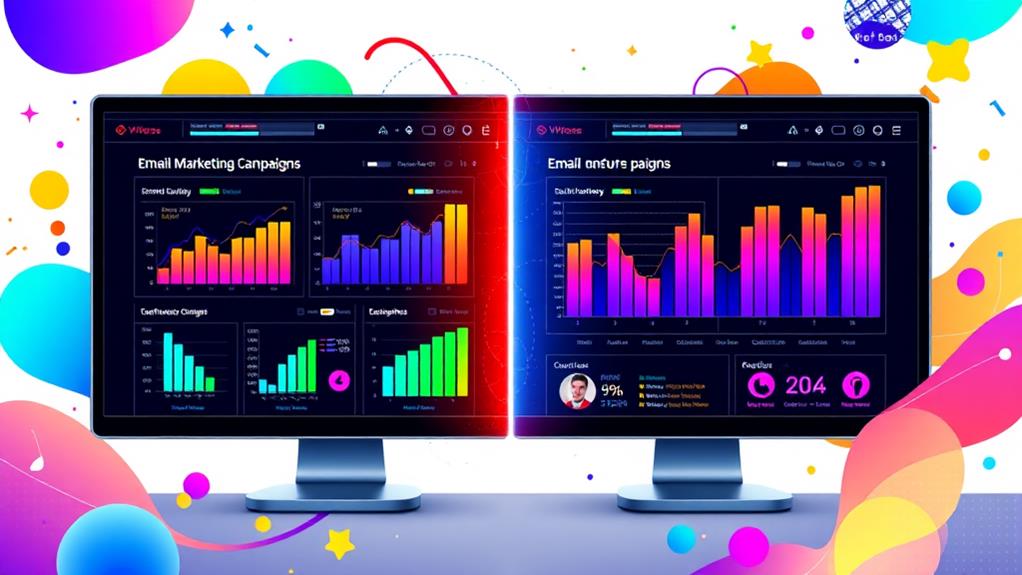For effective email list segmentation, leverage audience personas and data analytics to tailor communications precisely. Regularly update segments and employ automated tools for efficient management. Testing and analysis are critical for identifying high-performing segments. Avoid relying solely on demographics, as this can overlook actual behaviors. Prevent over-segmentation to maintain cohesive messaging, and never base personalization on assumptions without data validation. Ascertain that your strategies reflect individual behaviors rather than generalizations. Properly executed, these strategies can greatly boost engagement, conversion rates, and customer loyalty. Exploring the intricacies of this process can enhance your overall segmentation strategy.
Key Takeaways
- Do create segments using demographic, behavioral, and psychographic data for precise personalization.
- Don't rely on static lists; use dynamic segmentation for real-time updates based on user interactions.
- Do regularly analyze and update segmentation criteria to keep content relevant and effective.
- Don't over-segment as it may complicate campaigns; focus on meaningful, impactful segments.
- Do personalize emails by incorporating subscriber names and past interactions to enhance engagement and loyalty.
Understanding Email Segmentation
In the domain of digital marketing, understanding email segmentation is vital for crafting targeted and effective communication strategies. Email segmentation involves categorizing subscribers into distinct groups based on email characteristics such as demographics, behaviors, and interests. This strategic approach enhances relevance, thereby increasing open rates by 14.31% and doubling click-through rates by 100.95%.
By leveraging demographic data like age, location, and gender, alongside behavioral insights such as purchase history and engagement patterns, marketers can refine their messaging to meet specific audience needs.
Segmentation challenges often arise when attempting to maintain the accuracy and relevance of these groups. Dynamic lists offer a solution by updating automatically in response to changes in subscriber behavior, ensuring that segmentation remains precise as preferences evolve. However, implementing such systems requires a nuanced understanding of both technological tools and audience data.
To address segmentation challenges effectively, combining demographic, behavioral, and psychographic data is essential. This thorough view facilitates a deeper understanding of audience motivations and preferences, leading to more impactful and tailored email campaigns.
Ultimately, effective email segmentation is not merely a tactic but a cornerstone strategy in maximizing the potential of digital marketing efforts.
Importance of Personalized Outreach
Harnessing the power of personalized outreach transforms generic communication into tailored, impactful interactions that resonate with each recipient. This strategic shift from one-size-fits-all messaging to personalized content is driven by compelling data: open rates can surge by up to 29%, and click-through rates by 41%, as revealed by various studies.
By incorporating subscriber names and reflecting on past interactions, emails foster a profound customer connection. This approach not only boosts engagement by 20% but also enhances satisfaction, creating a more loyal customer base.
The effectiveness of personalized outreach extends beyond engagement metrics. Targeted communication based on audience segments and personalized offers can raise conversion rates to six times that of non-segmented campaigns. This is achieved by aligning the content with recipient preferences and behavioral insights, ensuring relevance and resonance.
In addition, when recipients perceive communication as relevant and tailored, unsubscribe rates can plummet by 25%, signifying sustained interest and connection.
Employing data-driven personalization strategies is paramount for successful outreach, enhancing effectiveness and fostering customer loyalty. In today's competitive landscape, personalized content is not just beneficial—it is essential for cultivating meaningful customer connections and driving business growth.
Benefits of Effective Segmentation
Effective segmentation is pivotal for achieving targeted audience engagement, as it aligns content with specific consumer interests, thereby increasing open rates by up to 14.32%.
This strategic approach not only fosters higher conversion rates, with personalized emails generating up to six times higher transaction rates, but also markedly reduces unsubscribe rates, contributing to a 27% enhancement in customer retention.
Targeted Audience Engagement
Releasing the full potential of your email marketing strategy begins with targeted audience engagement, a powerful outcome of effective segmentation. By aligning email content with audience preferences, businesses can notably enhance engagement metrics, a vital factor in the competitive digital marketing landscape.
Effective segmentation has been shown to increase open rates by up to 14.32% and click-through rates by an impressive 100.95%, underscoring the efficacy of delivering tailored content that resonates with specific interests and behaviors.
Utilizing demographic and psychographic data empowers marketers to craft messages that speak directly to the unique characteristics of each audience segment. This level of personalization not only fosters a deeper connection with subscribers but also reduces unsubscribe rates by as much as 25%.
Such strategic targeting guarantees a more dedicated and engaged audience base, which is essential for sustaining long-term relationships and brand loyalty.
Moreover, the ability to generate 760% more revenue from segmented campaigns illustrates the financial advantages of effective audience engagement. By focusing on delivering relevant and personalized content, marketers can drive meaningful interactions and foster a thriving community, ultimately maximizing the impact of their email marketing efforts.
Higher Conversion Rates
When businesses strategically implement email list segmentation, they reveal a significant opportunity to boost conversion rates, achieving increases of up to 760%. This remarkable uplift is a proof of the power of conversion optimization through precise audience targeting. By tailoring messages to resonate with specific segments, businesses can enhance transactional engagement, as personalized emails have been shown to generate six times higher transaction rates.
This direct correlation between segmentation and increased sales underscores the strategic imperative of understanding and leveraging audience preferences.
Further amplifying the potential for higher conversion rates, segmented campaigns have demonstrated an ability to improve click-through rates by as much as 14%. This increase in engagement drives more qualified traffic to landing pages, thereby enhancing the likelihood of conversion.
Behavioral segmentation, which aligns marketing strategies with users' actions and preferences, further raises conversion prospects by over 20%. These data-driven insights reveal that by focusing on audience targeting, businesses can effectively optimize their marketing efforts.
In essence, segmentation is not merely a tactical maneuver but a strategic approach to conversion optimization. By delivering relevant content to the right audience, businesses not only drive higher conversions but also foster a more engaging and profitable customer journey.
Reduced Unsubscribe Rates
A significant advantage of effective email segmentation is the reduction in unsubscribe rates, which can decrease by as much as 25%. This reduction is primarily due to the ability to deliver targeted content that aligns with specific audience interests, thereby addressing unsubscribe triggers directly.
When messages resonate with subscribers' preferences and behaviors, businesses witness enhanced engagement levels, fostering stronger audience retention. This strategic approach to segmentation not only curtails the frequency of unsubscribes but also leverages data to refine the content additionally.
Personalized emails crafted through segmentation efforts boast a 14% higher click-through rate and a 10% higher conversion rate compared to non-segmented campaigns. These metrics underline the effectiveness of segmentation in maintaining audience interest and reducing the likelihood of users opting out.
Moreover, regularly updating segments based on user engagement guarantees content remains relevant, a critical factor as 60% of users cite irrelevant emails as a primary unsubscribe trigger.
Automated segmentation strategies can sustain consistent subscriber engagement, effectively reducing churn rates by up to 15%. By delivering content that consistently aligns with user interests, businesses can minimize the occurrence of unsubscribe events and bolster long-term audience retention.
Techniques for Segmentation
Utilizing demographic and behavioral insights forms the cornerstone of effective email list segmentation by enabling marketers to tailor content that aligns with specific audience preferences.
Incorporating psychographic data enhances this approach by allowing for deeper personalization through the understanding of subscriber values and lifestyles.
Dynamic segmentation strategies, powered by automated tools, further refine these efforts by continuously adjusting lists based on real-time user interactions, ensuring that communications remain relevant and impactful.
Demographic and Behavioral Insights
Marketers' ability to effectively segment email lists hinges on the strategic integration of demographic and behavioral insights. Through meticulous demographic analysis, factors such as age, gender, and income level are scrutinized to tailor content precisely to the audience's characteristics.
However, to achieve deeper personalization, it is imperative to incorporate behavioral patterns like past purchase history and email engagement. By synergizing demographic and behavioral data, marketers can craft a thorough subscriber profile, guaranteeing that content is not only targeted but also resonates with individual preferences.
The integration of these insights can be additionally enhanced by incorporating psychographic factors:
- Interests and values: Align messaging with the emotional drivers of the audience to foster a more profound connection.
- Email engagement patterns: Utilize open and click-through rates to refine content delivery and timing.
- Purchase history: Leverage previous transactions to recommend relevant products and services.
This dynamic approach enables the creation of highly personalized marketing campaigns, ultimately leading to increased engagement.
Moreover, regularly analyzing and updating segmentation criteria based on user behavior is essential. This guarantees that content remains relevant, improves conversion rates, and bolsters customer retention.
Dynamic Segmentation Strategies
Building on the strategic integration of demographic and behavioral insights, dynamic segmentation strategies offer a sophisticated approach to refining email marketing efforts. By leveraging real-time data, marketers can execute real-time adjustments to segments, guaranteeing that email content remains aligned with the evolving interests of subscribers.
This dynamic approach is vital for maintaining relevance in communications, as subscriber preferences can shift rapidly based on their interactions and experiences. Implementing behavioral triggers enables automated responses to specific user actions, such as website visits or email clicks, facilitating timely engagement.
Such triggers guarantee that communications are not only personalized but also contextually relevant, enhancing the overall subscriber experience. Dynamic lists further streamline this process by automatically updating based on subscriber behavior, such as changes in engagement levels or purchase history, thereby optimizing segmentation and personalization efforts.
Combining multiple data types, including demographic and behavioral information, allows for the creation of thorough subscriber profiles. This holistic view supports more nuanced targeting strategies, improving the effectiveness of email campaigns.
Continuous testing and optimization of dynamically segmented campaigns, based on engagement metrics, is vital. This data-driven approach guarantees that segmentation strategies remain effective, maximizing the impact of email marketing efforts.
Psychographic Data Utilization
Incorporating psychographic data into email list segmentation offers a powerful strategy for enhancing marketing precision and effectiveness. By utilizing psychographic profiling, marketers can examine subscriber attitudes, values, interests, and lifestyles to craft more tailored and compelling messages. This approach not only increases engagement and conversion rates but also aligns with the audience's intrinsic motivations.
Techniques such as conducting surveys provide valuable insights into customer preferences, enabling a value based messaging approach that resonates deeply with distinct consumer segments.
- Conduct surveys to gather insights on customer preferences, focusing on values like sustainability and health consciousness.
- Analyze purchasing behavior in conjunction with psychographic data to tailor personalized offers that enhance customer loyalty.
- Segment audiences based on lifestyle choices to create campaigns for specific groups, such as fitness enthusiasts or tech-savvy consumers.
This segmentation strategy reduces unsubscribes by ensuring content aligns with subscribers' interests, fostering stronger audience connections. By understanding and addressing the psychological drivers behind consumer behavior, brands can deliver more meaningful and relevant experiences.
Ultimately, psychographic data utilization allows marketers to strategically position their messages, cultivating long-term engagement and loyalty through precise, value-driven communication.
Dos of List Segmentation
Effectively segmenting your email list is vital for maximizing the impact of your marketing campaigns. Implementing robust segmenting strategies involves leveraging audience personas to tailor communications effectively. By categorizing your subscribers based on user behavior and preferences, you can develop highly targeted campaigns that resonate with specific segments. This data-driven approach guarantees that your marketing messages are relevant and engaging, directly addressing the needs and interests of your audience.
To personalize communication strategies, utilize data analytics to gain insights into subscriber interests. This information allows you to craft content that speaks directly to each segment, enhancing engagement rates and fostering brand loyalty. Regularly updating these segments is essential, as it reflects evolving user interests and behaviors, maintaining the effectiveness of your email marketing endeavors.
Furthermore, continuous testing and analysis of campaigns are imperative. Identifying which segments perform best enables strategic adjustments that enhance overall engagement.
Employing automated tools for list management and segmentation streamlines the process, guaranteeing timely and relevant content delivery. By adhering to these dos of list segmentation, you can achieve a more personalized approach, driving better results and fostering stronger customer relationships.
Don'ts of List Segmentation
While understanding the dos of list segmentation is foundational for crafting successful email marketing strategies, recognizing the don'ts is equally important to prevent common pitfalls.
One major list segmentation pitfall is relying solely on demographics. This approach can lead to ineffective personalization strategies by overlooking subscribers' actual behaviors and preferences. Instead, a data-driven approach using analytics and feedback is essential for effective segmentation.
Moreover, over-segmentation should be avoided. Creating too many segments can complicate content creation and dilute the marketing impact. This complexity often results in disjointed messaging, making it difficult to maintain a cohesive strategy. Striking the right balance guarantees that segmentation enhances rather than hinders your marketing efforts.
Another vital mistake is making assumptions about subscriber preferences without supportive data. Generalizations can lead to misguided strategies that fail to resonate with your audience. Personalization should be based on individual behaviors and interests, not assumptions.
Key pitfalls to avoid include:
- Relying solely on demographics: Missing opportunities to engage subscribers through behavior-based insights.
- Excessive segmentation: Complicating content creation and diluting marketing impact.
- Assumptions without data: Leading to ineffective personalization strategies that miss the mark.
Maintaining List Hygiene
A strategic approach to maintaining email list hygiene is crucial for optimizing deliverability and engagement rates. Regular list cleaning, including the removal of hard bounces, is a critical component. This practice reduces the likelihood of emails being marked as spam, thereby improving deliverability.
Data-driven strategies can further enhance list hygiene by monitoring engagement metrics to pinpoint inactive users. Removing these subscribers is essential for sustaining a healthy list and enhancing campaign performance.
Engagement metrics serve as a valuable tool for identifying inactive subscribers who contribute little to engagement but can negatively affect overall results. Implementing a double opt-in process guarantees that only genuinely interested individuals join the list, which tends to result in higher engagement and reduced unsubscribe rates.
Additionally, providing clear unsubscribe options in every email allows uninterested users to exit gracefully, maintaining list integrity and compliance with legal standards.
Regularly scheduled list cleaning, ideally every 6 to 12 months, is advised to retain an active and engaged subscriber base. This proactive approach to list hygiene not only boosts engagement metrics but also enhances the return on investment for email marketing campaigns, guaranteeing long-term success.
Frequently Asked Questions
How Should You Segment Your Email List?
Segmenting your email list effectively requires a strategic approach that combines demographic targeting and behavioral segmentation. By leveraging data-driven insights, align messaging with subscriber motivations, ensuring personalization enhances engagement without complicating the marketing process or diluting efforts.
What Are the Dos and Don'ts of an Email?
To maximize email engagement, do align content with subscriber behavior, ensuring relevance and personalization. Don't overlook the importance of strategic targeting; avoid excessive segmentation and reliance on demographics alone to maintain impactful communication and improved conversion rates.
What Is the Difference Between Email Segmentation and Personalization?
Email segmentation categorizes a target audience into distinct groups for targeted messaging, enhancing engagement metrics. Personalization, however, tailors content to individuals within those groups, optimizing relevance and further boosting engagement through strategic data-driven customization efforts.
Conclusion
In summary, email list segmentation serves as a critical strategy for enhancing personalized outreach, optimizing engagement, and driving conversion rates. By employing data-driven techniques, organizations can tailor communications to distinct audience segments, thereby maximizing relevance and impact. Adhering to the established dos and avoiding common pitfalls guarantees the effectiveness of segmentation efforts. Additionally, maintaining list hygiene is essential for sustaining the accuracy and efficacy of segmentation practices, ultimately contributing to the strategic goals of marketing initiatives.




